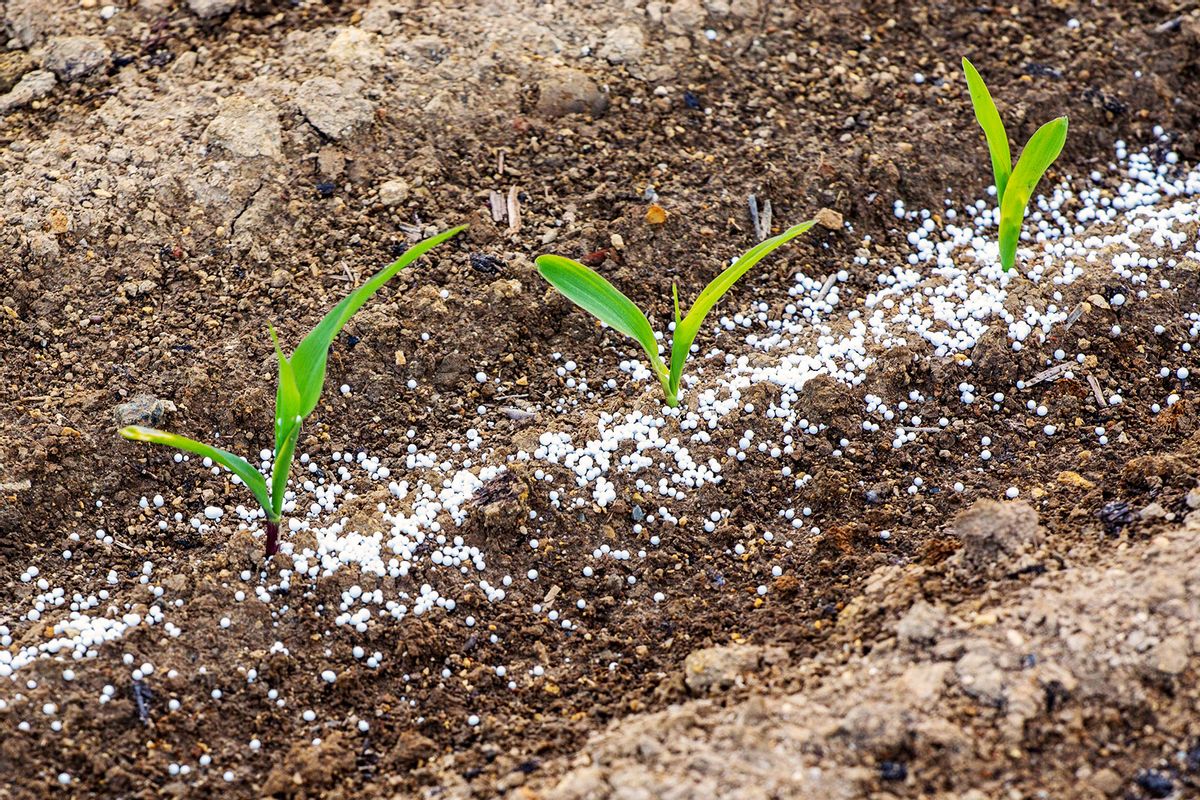A corn, wheat, or potato farmer browsing for fertilizers to improve crop yields might come across a product called Environmentally Smart Nitrogen (ESN). The promise of ESN, which, has been made by Canadian fertilizer manufacturer Nutrien (and before that, by the company's predecessor, Agrium) since 2000, is that its "polymer membrane," which encapsulates the nitrogen—a chemical element that is necessary for plants to grow—will release that input slowly and efficiently. The implication, in part, is that this will prevent an excess of nitrogen from poisoning water and soil, which is a common occurrence in communities where a lot of industrial farming takes place. A product safety page advises that the United States Department of Agriculture's EQIP program might even provide American farmers with some funds to purchase ESN as an environmental improvement practice. (In response to a request for comment, USDA issued a statement saying that "Any controlled release agrochemical could be included in a program payment for the associated conservation practice if it has been peer-reviewed through research, supported by the Land Grant University for use, and the conservation practice criteria includes controlled release.")
And yet, according to a new report released by the Center for International Environmental Law (CIEL) titled Sowing a Plastic Planet, ESN and similar so-called "controlled-release" agrochemicals produced by petrochemical giants — not just Nutrien's ESN but also ICL Specialty Fertilizer's Osmocote and BASF's DuraGuard ME, for example — are anything but environmentally advantageous or sustainable. In fact, their "polymer" shells are plastics that, when paired with synthetic chemicals, could actually increase the toxic risks associated with the chemicals and overload soils with even more plastics than before. The effects are a detriment to human, animal and planetary health. (FoodPrint reached out to Nutrien, ICL and BASF for comment; none of them responded.)
A potent threat to people and the environment
The report's authors write that synthetic agricultural inputs are already "some of the most toxic substances in use today," responsible for killing off soil microorganisms, creating chemical-resistant weeds and endangering the health of the farmworkers who spray them, for starters. They've also been shown to exacerbate the effects of climate change, since applications of synthetic nitrogen fertilizer causes soil to emit the potent greenhouse gases carbon dioxide and nitrous oxide.
Concurrently, microplastics are turning up in our water, soil, air and in human blood, tissue and waste; they emit greenhouse gases as they degrade, also kill off soil microorganisms, and can cause cancers and neurological and respiratory (among other) problems when we ingest or inhale them.
By using plastics to encapsulate chemical inputs that are applied directly to soil and crops, manufacturers are creating products that are "more dangerous, and for longer," says CIEL president Carroll Muffett. "There's a long-standing recognition of the profound human health and environmental risks of pesticides and fertilizers, and a growing recognition of the diverse impacts of the plastics lifecycle and the pervasive presence of plastic pollution. Here, these issues are converging in a way that is really stark in highlighting the risks of our fossil economy."
A toxic stew
Plastic-coated agricultural chemicals have been around since the 1960s, although companies marketing them as "planet-safe" and "sustainable" is new, and the chemical companies' own research shows these claims to be not well-substantiated, say the CIEL authors. The United Nations' Food and Agriculture Organization (FAO) estimates that 100,000 tonnes of plastic per year are dumped into the environment from plastic-coated fertilizers alone; according to CIEL, agrochemical companies are planning to vastly expand the market for these and other encapsulated chemicals, which will let loose even vaster amounts of microplastics on the environment.
Both plastics and agricultural chemicals are harmful in their own rights. Making matters so much worse is the fact that plastics can adsorb those chemicals they encapsulate — that is, the chemicals adhere to their surfaces; plastics also "adsorb other toxins from the environment," says Muffett, to become what the UN Environment Programme calls "toxic time bombs." Muffett points out that "when the oil industry was researching oil pollution in the Gulf of Mexico in the 1960s and '70s, they kept finding microplastics with oil and other pollutants adhered to them" — an indication that the industry has been aware of this dynamic for over 50 years.
The CIEL report cites a 2019 study from Oregon State University, which found that "a common insecticide with the active ingredient encapsulated in nanometer-sized plastic was more toxic than applying the same active ingredient" on its own. Encapsulation, one of the OSU researchers told CIEL, "is thought to enhance toxicity and mobility, because it prevents the active chemical ingredient from breaking down in water, which would dilute the toxicity, and it allows the chemical to be transported further away from the point of application, enhancing potential exposure."
Meanwhile, those toxically loaded microplastics break down into even smaller nanoparticles, which accumulate in soil at a rate of 50 kilograms per hectare per year, and they remain for no one knows how long. From there, they leach into air and water, and are also taken up by plants growing in that soil — all of which are pathways for these plastics to enter the bodies of humans and wildlife. In the soil itself, microplastic pollution might interfere with nutrient cycling, negatively impact plants' rooting ability and earthworms' growth and health, and impair soil's ability to store carbon.
These encapsulated chemicals are "not only dangerous, but also unnecessary," according the CIEL authors, who write that effective, non-chemical alternatives to their use — sulfur and biochar among them — exist.
Keeping the fossil fuel industry in business
Anna Lappé, director of the Food Sovereignty Fund at Panta Rhea Foundation, which provided some support for the CIEL report, says the addition of plastics to agricultural chemicals — far from being essential to the health and productivity of food systems — "is one of the many worrisome ways the fossil fuel industry is continuing to find new markets," while environmental legislation has increasingly focused on switching from oil and gas to wind and solar power.
Plastics and many agricultural chemicals are made from fossil fuels, and Muffett connects the dots between the various industries. Oil and gas businesses, he says, "have very active agricultural chemical businesses, which [in turn] have large-scale businesses in the production of plastic resins and related polymers — these are the corporate actors often pioneering the technologies that allow this sort of encapsulation to work . . . and they have a clear vested interest in keeping plastics in these products."
Margaret Reeves, senior scientist at Pesticide Action Network North America (PANNA), calls the CIEL report "a big eye-opener; even folks who study and follow the industry are surprised [by it], which is pretty alarming." She's concerned about links the report establishes between controlled-release chemicals and damage to the soil microbiome, which only increases the need for increased use of fertilizers, "creating a feedback loop," she says. She says the obvious solution to the addition of microplastics to agricultural chemicals would be to ban those chemicals outright — unlikely in the US with an Environmental Protection Agency (EPA) chemical office that "isn't doing what they're supposed to do," she says, "to prohibit the use of all but a miniscule number of highly hazardous pesticides. The agency could, however, and should, refuse to register the formulations of the pesticides that include microplastics; that should be an immediate request."
Nevertheless, she sees hope in legislation that was enacted in California, which banned the insecticide chlorpyrifos starting in February 2020. "There's 10,000 more [chemicals] behind it" needing to be banned, she says, including the remainder of the organophosphate pesticides, "but what happens in California is important globally . . . and that action had a big impact on the subsequent federal [EPA] decision" to ban the pesticide. (Although, EPA still permits the use of chlorpyrifos, which damages the human nervous system, for some non-food related uses.)
Muffett calls encapsulated agricultural chemicals "the very definition of a controllable source of pollution" since he says they're wholly unnecessary, and one the EU's chemicals agency has already been looking to regulate. Recognizing the challenge of getting the US to ban such chemicals outright, he believes that action by the EU and "a major market like California could dramatically transform the economics associated with producing these materials," he says, in addition to improving the environment and human health in the regions where those products are disallowed. "By raising awareness of the content of [controlled-release chemicals], we give more and more farmers the recognition of what they're using and the option to opt out, and more and more members of the public the tools to demand action and change."


Shares